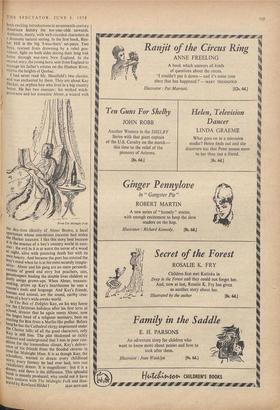Grown-up Children
The Bitter Glass. By Eilfs Dillon. (Faber, 15s.) Mohawk Valley. By Ronald Welch. (O.U.P., 12s. 6d. Illustrated.) Warm° for children is in transition, reflecting changing relationships between grown-ups and children, and the recognition that they are often capable of more mature behaviour than we are. It also reflects our uncertainties: family violence, love and hatred, failure and death are no longer tabu in children's fiction; but with our awkward half-insights we deal with them there as tenta- tively as we fear we do in life. Nor, faced with their critical candour, can we project our own childhood into their stories as wholeheartedly as the Victorians could.
The first three books reviewed here are interest- ing examples of the new attempt to write realisti- cally for children on a serious level. All, good though they are, tend to fall between two stools; had the authors been writing unselfconsciously for themselves they might have given their true childish feelings fuller rein. Trinidad in the Thirties was a holiday paradise for the young de Tassignys and their English friend Ken, but a frustrating limbo for the fugitive from Devil's Island whom they befriend. A confusing number of adults get in their way and they come up against world and local politics. Their growing up is jolted into a new pattern by their father's death, and they can better understand the young Frenchman's ingratitude for their intervention. I liked the author's treatment of complex motives and interests : but a teenager's reaction was,
`These people are far too understanding—you'd think they'd all been analysed!'
Paul Berna, who scored a success with his A Hundred Million Francs, now tries his hand at science-fiction. The scene is a Los Alamos near Bordeaux where men working on a project to colonise the moon are imprisoned with their machines. He sees this claustrophobic little chaos through the eyes of the boys who are allowed to share their fathers' dedicated isolation and their visionary absorption with the moon (M. Berna is here at his best), though not, realistically enough, the final journey. But why no women or girls? For me there is a metallic, stiff-lipped taste about this high-flier which the rather sticky trans- lation does nothing to ease.
As in so many novels about Italy, air, light and architecture dominate the characters in Four Odd Ones. Conrad, a Polish-Italian aristocrat, has to prove to his stuffy relations that he is now sane enough to manage his own inheritance and adopt two orphans, an English girl and her Italian cousin. What Miss Elizabeth Bowen would have made of it! But Miss Trevor has to fulfil certain limited requirements of taste, information and psychological truthfulness. This she does in full measure, taking Catholicism and Abruzzi politics sympathetically in her stride in this pleasant Ann Bridge model tailored for girls.
Miss Dillon writes wholeheartedly for herself, with no young audience obviously in mind; and I think she is the most successful. A group of young people are virtually besieged in a holiday house on the Connemara coast (the time is 1922), with a wounded man and two sick babies on their hands, and no doctor. Their situation is movingly contrasted with its setting of sea and landscape, a lovely remote world of people and customs unfor- gettably described.
The Forest Fighters and Mohawk Valley are both exciting introductions to seventeenth-century American history for ten-year-olds onwards. Authentic, meaty, with well-rounded characters in a dramatic natural setting. In the first book, Bun- ker Hill is the big 'I-was-there' set-piece. Two boys, rescued from drowning by a rebel gun- runner, fight on both sides during their long trek home through war-torn New England. In the second story, the young hero, sent from England to manage his father's estates on the Hudson River, storms the heights of Quebec.
I had never read Mr. Masefield's two classics, and was enchanted by them. They are about Kay Harker, an orphan boy who lives in a big country house. He has two enemies : his wicked witch- toverness and her associate Abner, a wizard with
the day-time identity of Abner Brown, a local sportsman whose murderous ancestor had stolen the Harker treasure. I like this story best because it is the essence of a boy's country world in sum- mer: the evil in it is at worst the terror of a wood at night, alive with pouncing death but with its °w11 beauty. And because the poet has entered the boy's mind when he is at his most securely imagin- ative : Abner and his gang are no mere personifi- cations of greed and envy but poachers, cats, gamekeepers leading the double lives children so Justly assign grown-ups. When Abner, treasure- seeking, prizes up Kay's hearthstone he uses a mason's tools and language. And Kay's friends, human and animal, are the sound, earthy crea- tures of a boy's wide-awake world. In The Box of Delights Kay, on his way home for the Christmas holidays after his first term at school, dreams that he again meets Abner, now the bogus head of a religious seminary, bent on long the Box from a Merlin-like pedlar. Before long he has the Cathedral clergy imprisoned under the Chester hills; of all the good characters, only Kay is still free. The plot thickened so richly Indoors and underground that I was in poor con- dition for the tremendous climax, Kay's deliver- ance of his friends from the flooded caverns in time for Midnight Mass. It is as though Kay, the schoolboy, wanted to dream every childhood Story, every fantasy he had ever had, into one valedictory dream. It is magnificent : but it is a d. ream; and there is the difference. This splendid been is meanly produced; why could not it have been uniform with The Midnight Folk and illus-











































 Previous page
Previous page